Few affordable divers command such a reverence as the Orient Mako. For over a decade the Mako has been one of the most go-to recommended dive watches for both first-time watch-buyers and seasoned collectors alike. But within that same breath of appreciation, proponents of the Orient Mako were also quick to express the piece’s quirks and downsides. Over the past 14 years though Orient has taken note and improved some of these items, like better lume and an improved bracelet experience.
However one point of criticism always seem to stick without any remedy in sight: the movement. The Orient Mako originally launched with the Orient 46943 – an automatic 21 jewel movement with accuracy issues, lack of hacking, and a quirky date change button. For a while it seemed like the watchfam would have to just be content with the Orient 46943 caliber.
Enter: Orient Mako II. Orient’s answer to the movement-centric woes of the watchfam is the new Orient F6922 caliber. Although Orient has been pioneering advancements within their in-house movement manufacturing, these improvements were only really available within the Orient Star line or the highest tier (and rarely seen) Royal Orients. Entry level Orient pieces weren’t seeing the movement love. That ends with the Orient Mako II.
But is upgrading the movement enough? Is it a “lipstick-on-a-pig” situation or is the movement upgrade exactly what the Orient Mako needed? Let’s find out. The specific Orient Mako II I’m reviewing today is the ref: FAA02002D9.
The Movement:
The original Orient 46943 Caliber that launched with the Mako back in 2004 was actually a legacy Orient movement dating back to the 70s. In fact, the 46943 is actually the result of Orient striking a technology licensing deal with Seiko for the brand’s popular Seiko 7006 caliber. The only issue was that the 7006 had a date wheel, but no day wheel. So once the Seiko 7006 technology was licensed, Orient modulated the design to feature a quickset day wheel controlled by a 2 O’clock button independent of the crown/keyless works mechanism.
The Orient 46943 was born and has been in continued production since. The 46943 was already 30 years old when it debuted in the original 2004 Orient Mako, so the inclusion of the new Orient F6922 caliber in the Orient Mako II is huge news. Before we start talking about specific functions, let’s compare movement specs at a high level.
Orient 46943 vs Orient F6922
| Orient 46943 Specs | Orient F6922 Specs |
| 21 jewels | 22 jewels |
| 40 hour power reserve | 40 hour power reserve |
| 21,600 bph | 21,600 bph |
| -25/+35 sec | -15/+15 sec |
| No Manual Winding | Manual Winding |
| Does Not Hack | Hacks |
| Day/Date (Day quickset button) | Day/Date (both in keyless works) |
Power reserve, and bph are basically identical between the two. But the F6299 is a clear improvement in terms of expected rated accuracy. Plus the big winners here are the inclusion of hacking, manual winding, and an integrated quickset day feature on the new Orient Mako II.
The hacking is smooth and the clicking action feels very natural. The ability to hack the movement (stop the seconds hand when the crown is pulled out) greatly improves the wearer’s ability to track the accuracy of the watch. Plus now having the ability to manually wind the watch is convenient – at least it is for me since it’s not uncommon for me to have a watch sit idle for more than 3 days while I work through my regular wrist-time rotation.
Being able to pick the watch up after the power reserve dies and simply manually wind the movement via the crown (as opposed to having to shake it like morning maracas) is both convenient and satisfying. The interesting thing to note is that the winding mechanism has a satisfying bit of bite to it as opposed to being buttery-smooth like some other movements. This is a characteristic I’ve also noted with the Orient Star WZ0071DJ’s movement.
The integrated quickset hasn’t evoked the type of reaction from me that I thought it would. Obviously the original 46943’s modulated day changing button was a functional feature, but it also became an iconic design feature of this affordable diver.
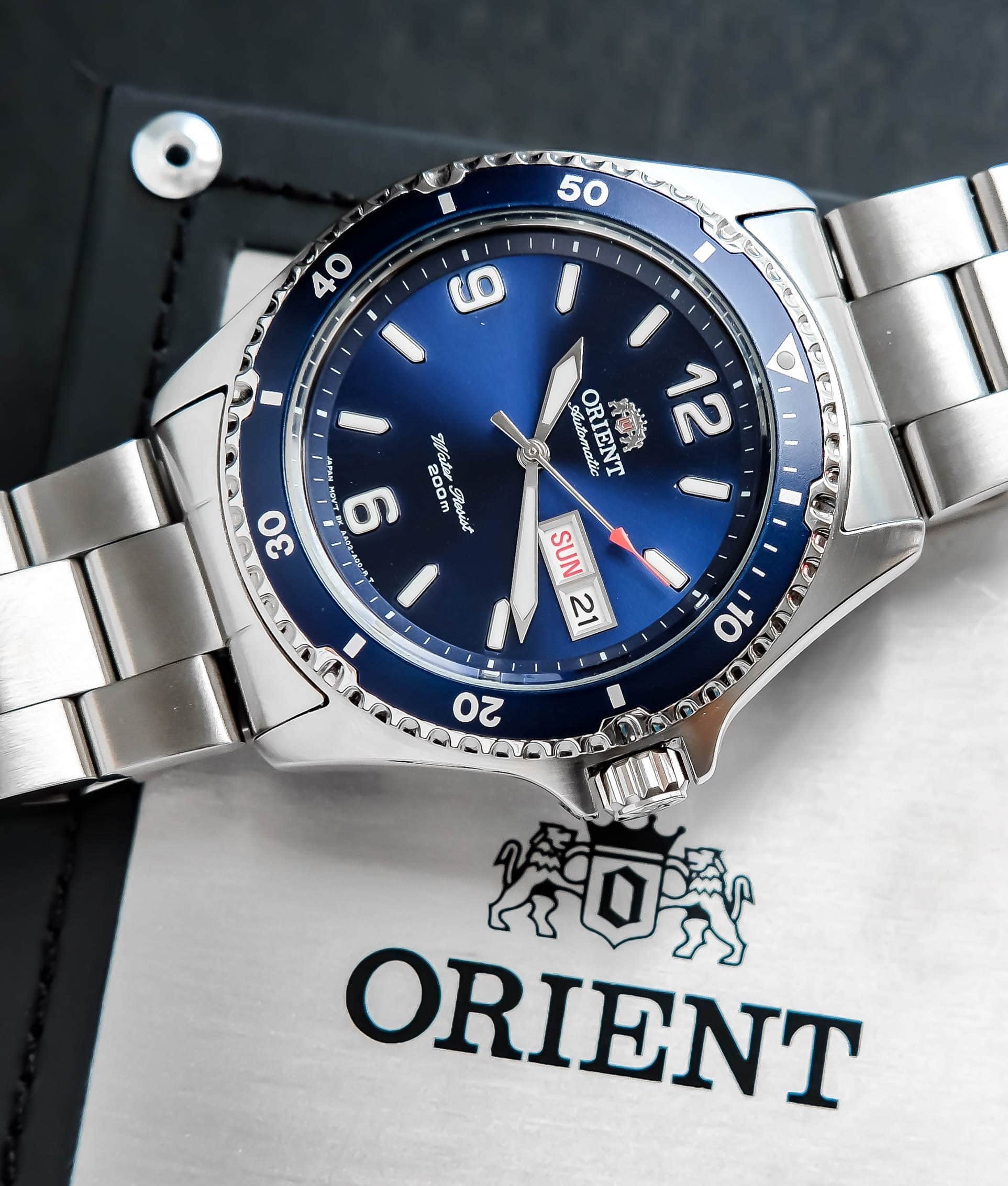
$140 on Amazon
Case
• 41.5mm x 47mm x 13mm – beautifully classic case shape with excellent mix of polished and brushed surfaces – bezel can be hard to turn at times
Dial
• Deep blue sunburst finish with applied markers – also available with in a black dial or a Pepsi version
Strap
• hollow end links but overall bracelet quality much improved from previous models
Movement
• Orient Caliber F6922 – manual winding, hacking, and improved accuracy – many steps beyond the previous model’s movement
With the day changing button gone and the day quickset integrated into the keyless works mechanism (which is the industry standard today) I recognize that this is a more traditionally convenient experience.
However, I can’t help but feel like the piece has taken a step towards becoming a piece that’s more “traditional” – not to say that this is necessarily a bad thing. However, the quirkiness of the 2 O’clock button was such a hallmark of the original Orient Mako. However I have to side with my mind on this one (sorry, heart) and agree that the choice of removing the button was ultimately the smart play. Hell, if anything this now makes the original Orient Mako divers even more cool/collectible.
The Case
The Orient Mako II does an excellent job of presenting a case profile that’s both familiarly accessible while still retaining some unique flair. Measuring in at 41.5mm in diameter, 47mm lug to lug, and 13mm thick, the Orient Mako II is incredibly wearable with these classic dimensions.
My favorite aspect of the case is how well the Orient Mako II transitions surface changes. For example the case sides are high polished, but the top of the case/lugs are matte brushed. The line between the two surface finishes is almost indistinguishable, the transition just seamlessly occurs without a harsh, sharp-line transition point. It’s a note of refinement that I feel like doesn’t always get mentioned when folks are talking about the Orient Mako series.
Also, the way in which the bracelet’s endlinks meet the case is done so well to the point where the bracelet becomes an organic expression of the case and vice versa. I’ve handled other pieces before when the bracelet was nice and the case was nice – but when they were together they just weren’t jiving. That’s not what’s happening here with the Orient Mako II – there’s magic where case and bracelet meet.
Unlike the Orient Mako II USA, this Orient Mako II FAA02002D9 features a mineral crystal and not a sapphire crystal. For me that’s not really a deal breaker since the use of mineral helps keep the Orient Mako II price very affordable. The piece also features an updated aluminum-insert bezel. Where previous Mako models featured 60-click bezels, this one has 120 clicks. In term of everyday use, the bezel can be a bit difficult to turn.
However I attribute this to the sloping angle of the bezel’s user-facing top as opposed to the mechanical resistance of the bezel click mechanism. It can be physically difficult to get a good grip on the bezel. However once the bezel moves the action is solid and releases a really satisfying *click* upon turning. The sloping coin edge of the dive bezel is high polished to match the sides of the case. The Orient Mako II is also rated for 200m of water resistance and features a screw down crown and screw down caseback.
The Dial
It’s easy to miss, but there is a wonderful sunburst sheen effect on the dial. It adds a very dynamic fluidity to the blue hues of the piece. The rich blue creates an excellent contrast for the applied dial markers by allowing them to pop. The markers are lined in thin, polished metal and filled with lume. The lume on this FAA02002D9 is appropriate for the price point (but obviously some contemporary Seiko competitors will give this particular Orient Mako II a run for its money). The outer perimeter of the dial features a raised, beveled chapter ring with minute and seconds ticks.
The thin metal detailing on the markers is also present on the day/date window and it creates a very finessed and balanced effect (especially with the applied classic Orient logo). The polishing is also carried into the Orient Mako II’s hands. In terms of design the hour and minute hands are sword-style while the seconds hand is a red tipped spear point. The red adds a really subtle but refreshing pop of color against the blue and white of the piece.
The Bracelet
I’m honestly quite surprised with the Orient Mako II bracelet quality. To match the classic sub-type case the bracelet features oyster-style links. The tops of the links are brushed while the sides are polished. The endlinks are unfortunately hollow, but they are surface treated to the same quality of the rest of the watch. Even though the endlinks are hollow it doesn’t negatively impact the overall quality of feeling for the the bracelet. However once you take the bracelet off and physically handle the endlinks, you can certainly tell it’s an area where they decided to cut cost.
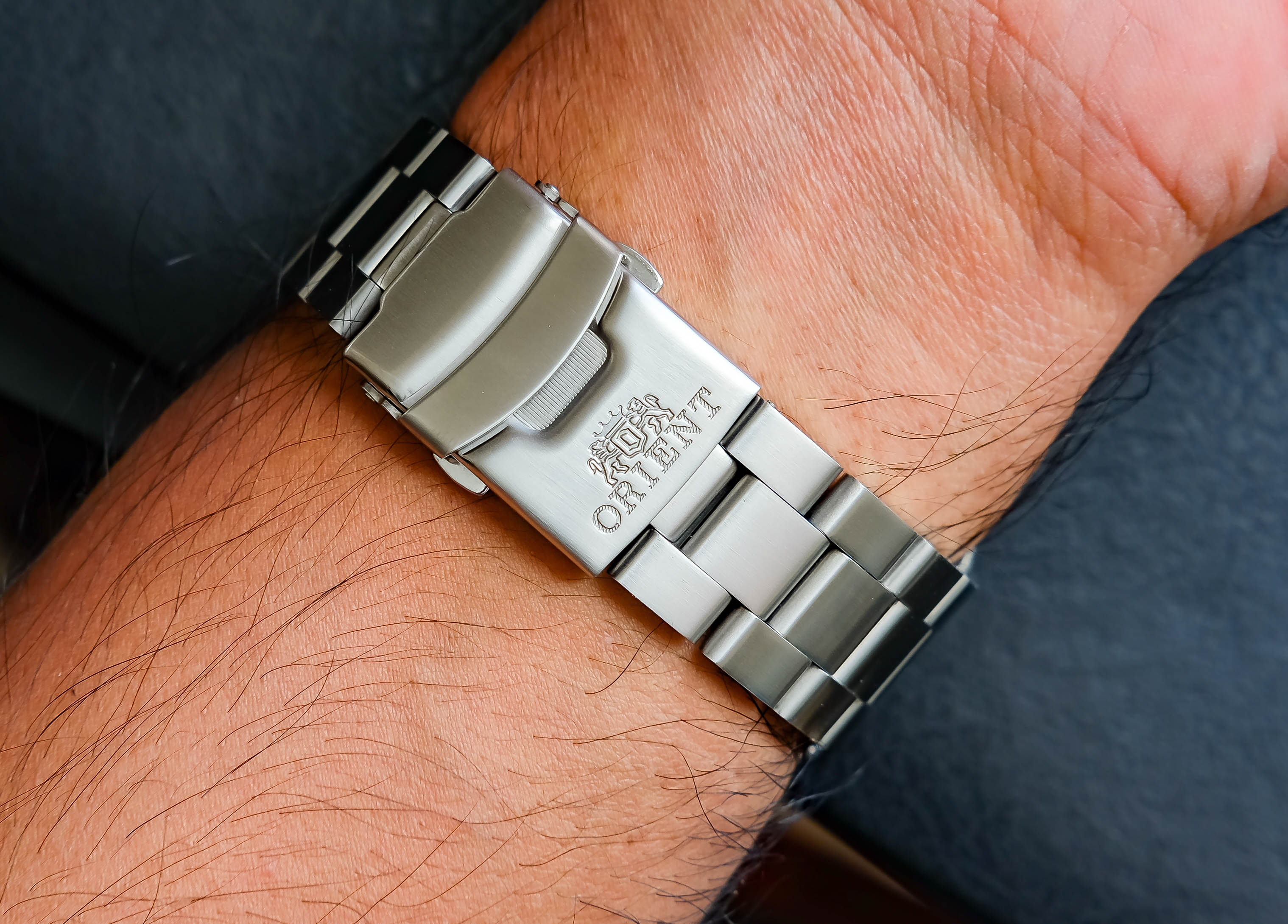
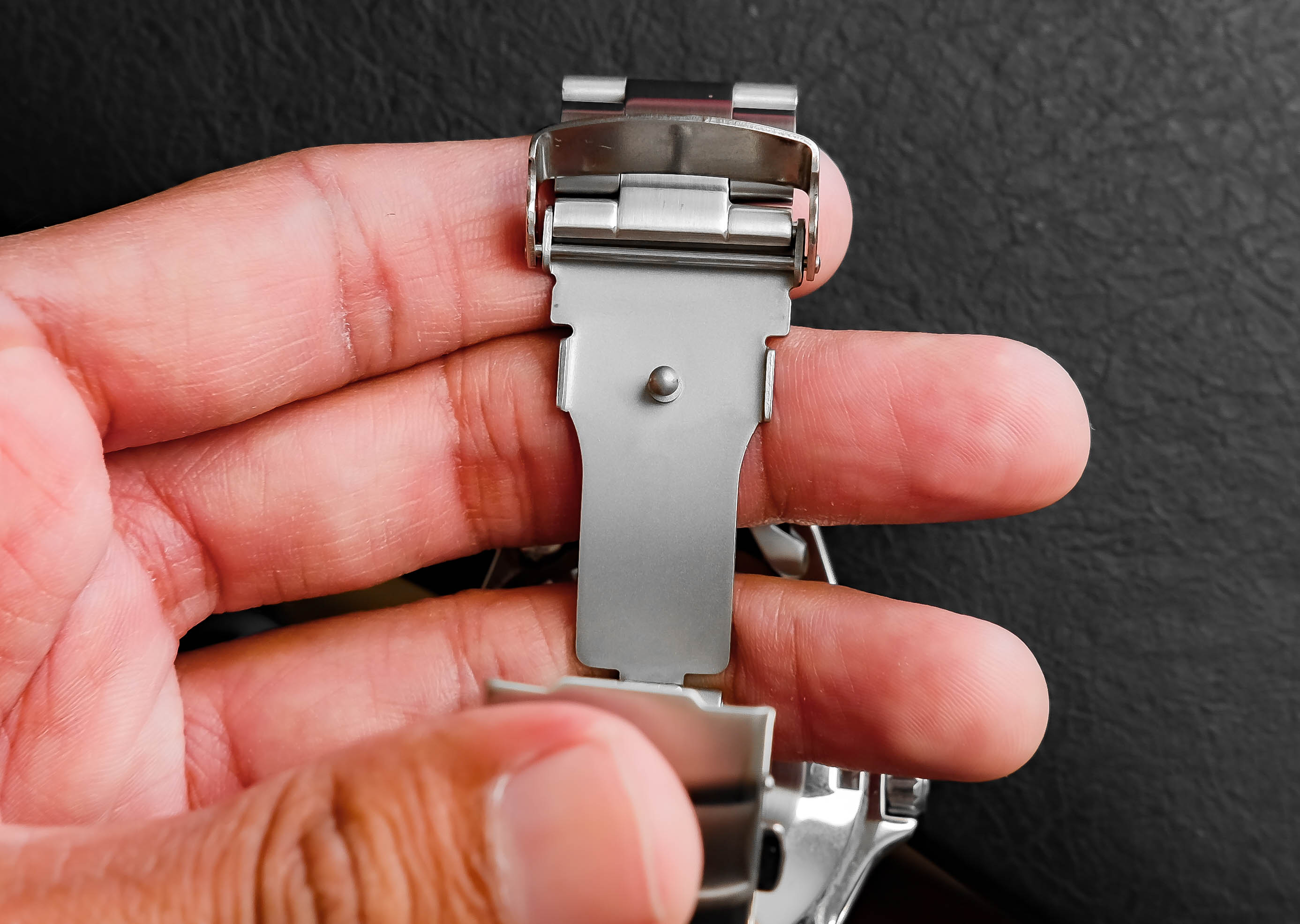
Clasp quality is also strong for a piece in this price range. It’s a double-locking, push-button clasp with micro-adjustments. The Orient logo is featured on the clasp and compared to the impressions of the logo on other Orient pieces, the detail of the stamping here is strong. An interesting feature of the clasp is the choice to sand-bast the inner folding joint as opposed to having it be high polished which you tend to see more regularly. For me I appreciate the sand-blasting more since it shows an attention to detail.
Final Thoughts
There are obvious pros and cons with the Orient Mako II FAA00202D9, however this piece has something that many watches try for but can’t achieve. The congruence of all its disparate elements, good and bad, result in a wearing experience that’s greater than the sum of its parts. It’s like taking the recipe for a delicious dish – you isolate the ingredients and eat them on their own and it’s most likely going to be weird (you ever eaten raw cumin before?).
But when you put them all together, there’s a special magic that can occur only when seeing the parts as a whole. That’s what the entire Orient Mako line achieves. Even though updating the 49343 movement with the F6922 removed the iconic day button, the Orient Mako magic is still there with the Mako II FAA02002D9.
The Orient Mako II FAA02002D9 is currently available from Amazon for a steal*. The Pepsi version (FAA02009D9)* and Black dial (FAA02001B9)* are also available for equally incredible prices. Be sure to check current cost in the links though since prices normally fluctuating a few bucks or so.
Also be sure to check out Michael’s review of an earlier Orient Mako 46943 piece.

Co-Founder and Senior Editor
Kaz has been collecting watches since 2015, but he’s been fascinated by product design, the Collector’s psychology, and brand marketing his whole life. While sharing the same strong fondness for all things horologically-affordable as Mike (his TBWS partner in crime), Kaz’s collection niche is also focused on vintage Soviet watches as well as watches that feature a unique, but well-designed quirk or visual hook.
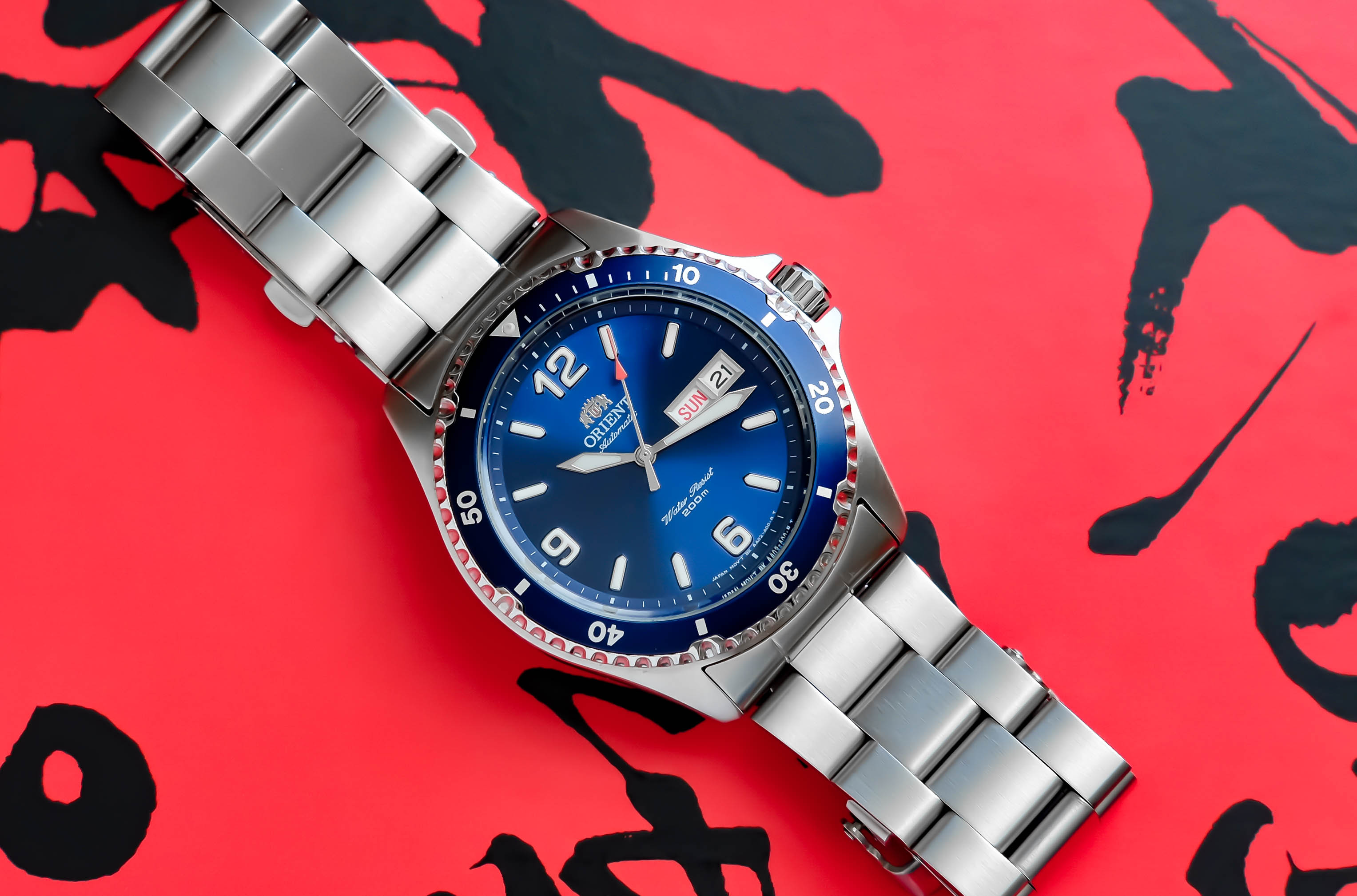
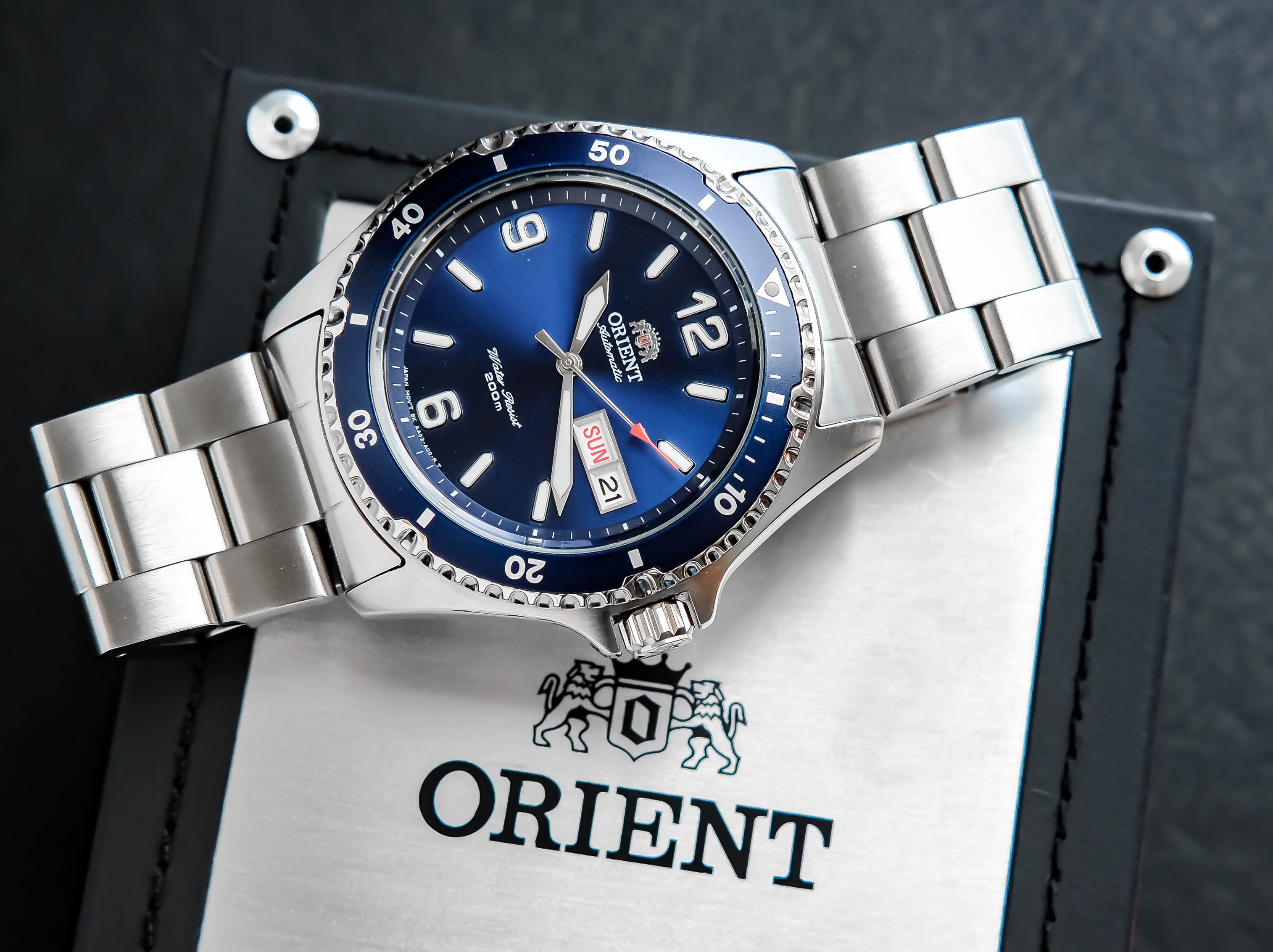
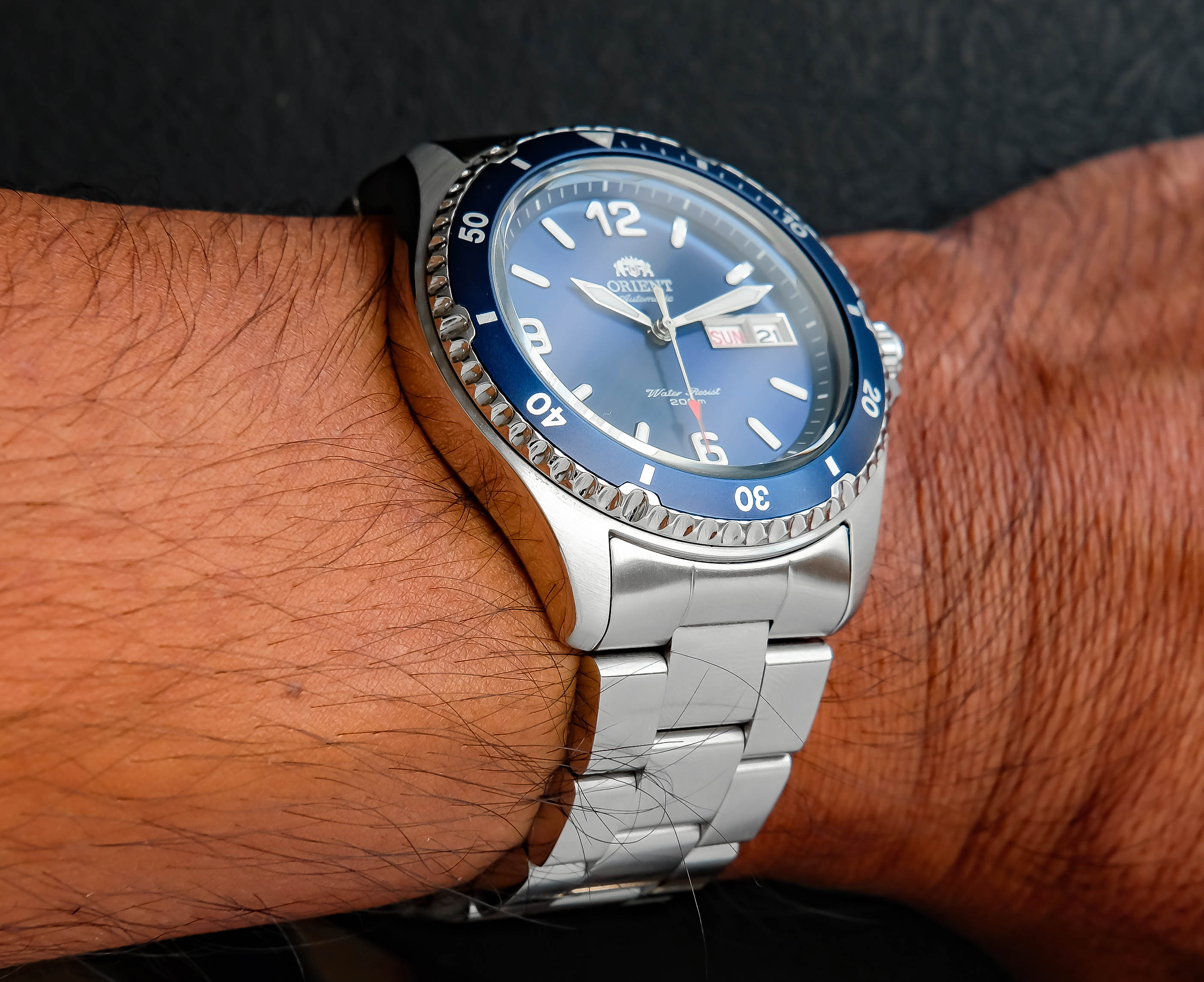
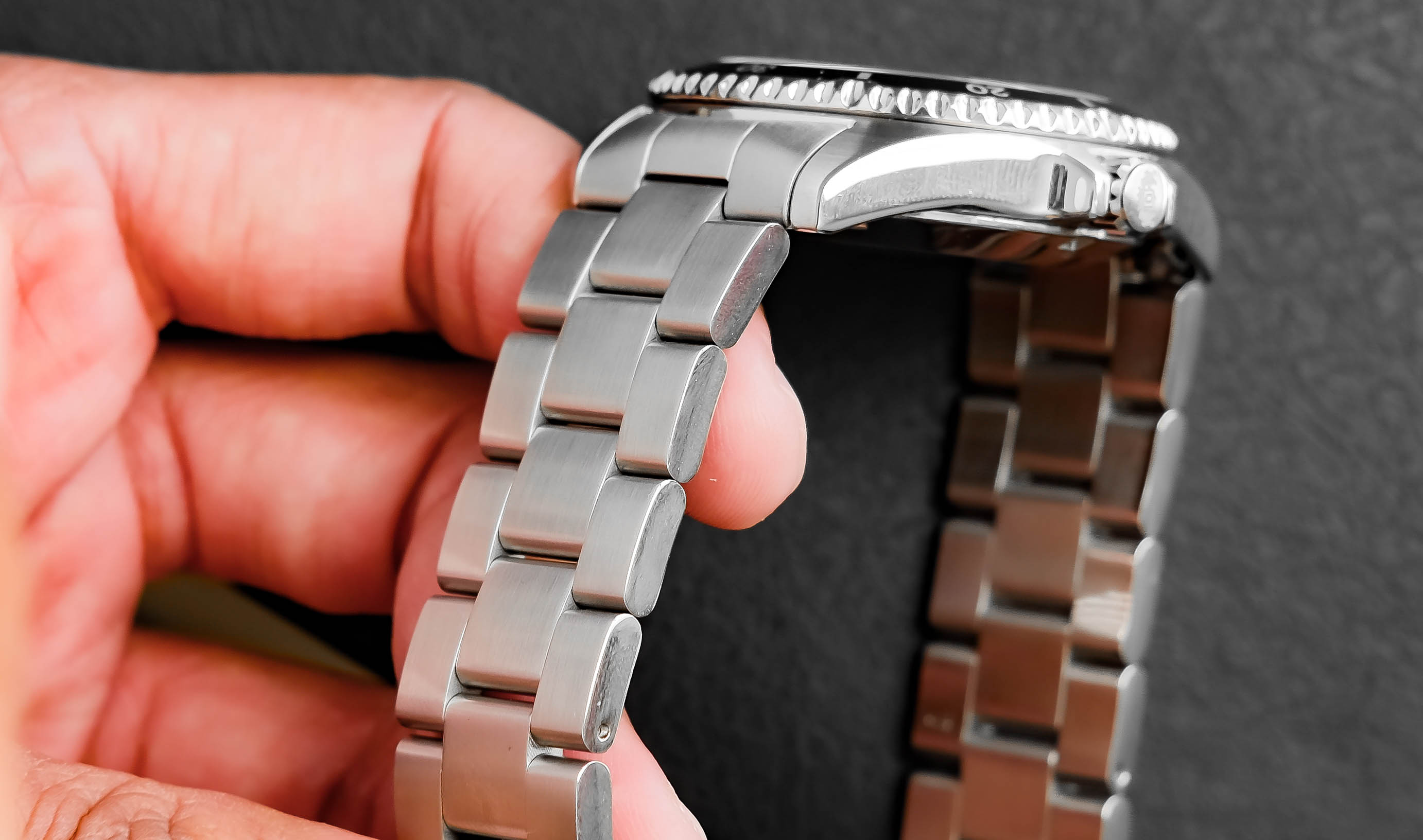
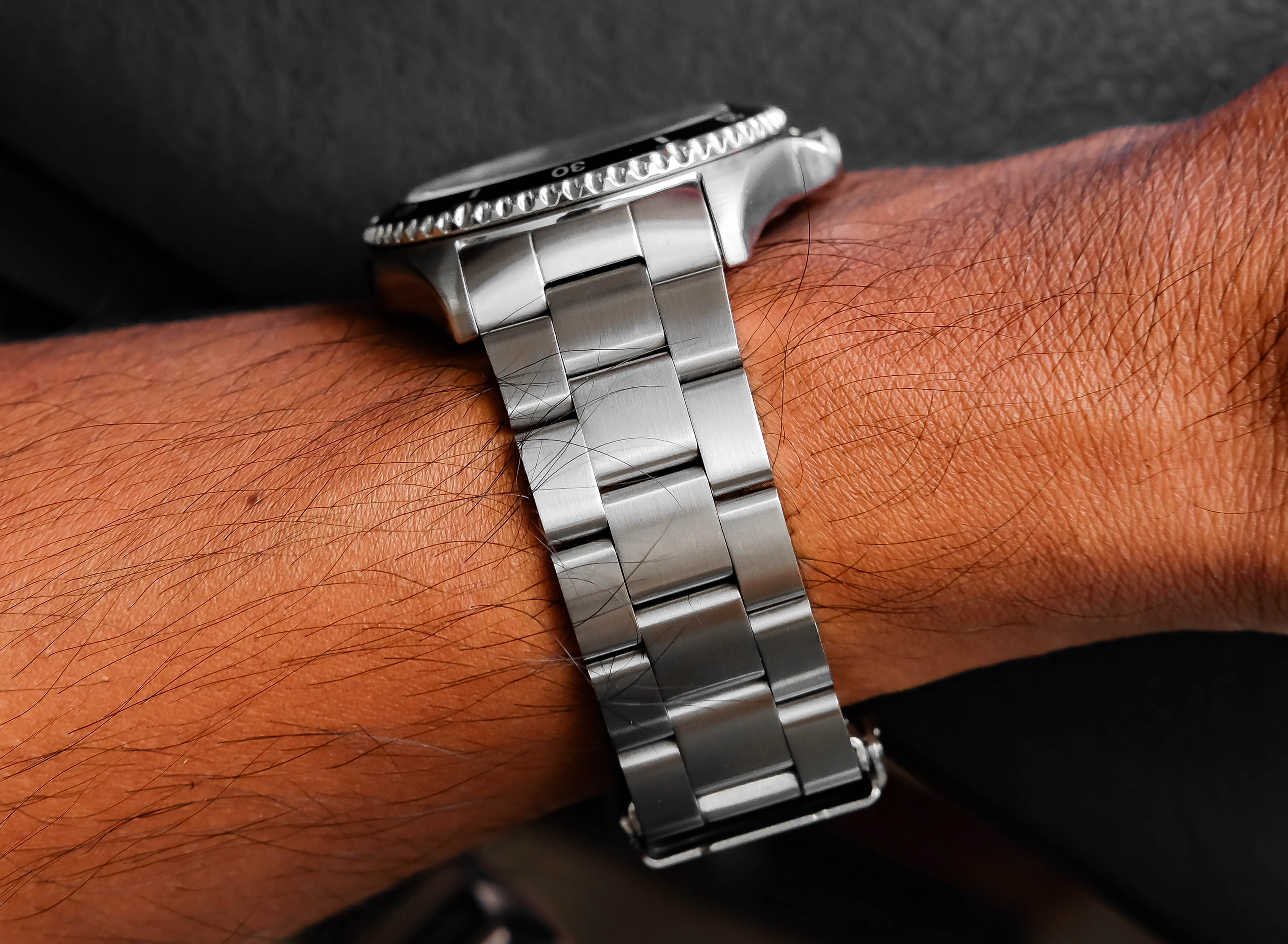



Great review Kaz! I also like the addition of the video review embedded in.
Very informative and comprehensive review.
Great review. Does the 41.5 mm case measurement just include the glass portion or does it also include the blue ring with the minute markers surroudning it? Would this oversized for a 7 inch wrist?
Good watch. Only complaint is the band is too wide: makes the case seem smaller.
I bought my Mako II a couple of years ago, but I never wear it. The deal breaker for me is in winding the crown. It feels like there are grains of sand poured down the tube. I took it back to the shop and the owner grabbed half a dozen Orients from the display window and asked my to give them all a wind. They all had that gritty feeling. So, the Mako sits in its box and every time I hear the word Orient, I think of the beach on a windy day.
That sound of “grains of sand poured down the tube” is the normal sound any automatic movement with hand-winding capabilities will make if it has the hand winding feature capability. It is a shame the shop/owner did not tell you that. I have watches from Longines, TAG Heuer, Rolex, Bulova, Omega, Mido, some old Seiko, and many other brands that do the same sound when wound. This sound means the ratchet and the mainspring are in excellent conditions, and in no way the movement is defective. If you do not have this sound it is either not-a-hand-windable automatic watch, or there is some parts missing/broken. After all, this feature was re-incorporated just for the people who wants to wind it by hand instead of shaking it. But think about this- Unscrewing and screwing the watch again on a frequent basis, just to wind it makes the crown gasket to wear faster compared to when you just shake the watch. So my advice is for you to use and enjoy this watch as it is and to forget those mind phantoms………
This watch is a very nice one, specially when you have the removal of the button/hand at two O’clock in the case, and getting an improved movement. Lamentably as it is when purchased from the dealer, it doesn’t meet the minimum ISO 6425 requirements by not having a luminous sweep seconds hand. I fix it, together with the aluminum bezel and the mineral crystal by getting those parts from a reputable watch parts dealer. Then the watch was tested and met the water resistance stated. That “sandy” sound some users here feel when winding the watch by hand IS the sound of the ratcheting of the mainspring, and it also is the same in other watches that have this feature, it is not a defective sound, it is part of its working ways, so do not feel this is bad. On the opposite, it shows the mainspring and ratchet are in excellent condition. Otherwise, this watch is perfect, and I never had a problem with the 120-click bezel, for me it is also perfect!!!!! Five Kudos for you Orient for such an excellent watch!!!! But please, add that luminous sweep second hand and become PERFECT!!!!